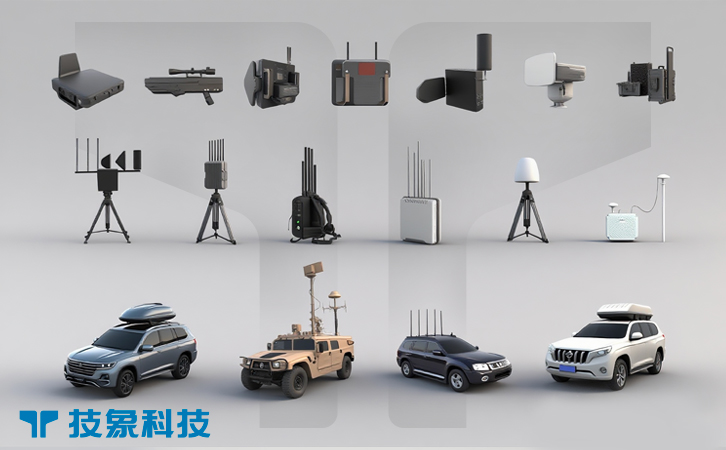The widespread adoption of drones, exceeding 6 million units globally in 2025, has amplified immediate threats, as rogue UAVs can appear suddenly in restricted areas, demanding quick action. Portable counter-drone guns, handheld devices that disrupt or neutralize drones via RF jamming or spoofing, have become essential for on-the-spot defense. These rifle-like tools allow security personnel to target specific drones from a distance, forcing them to land or return home without requiring heavy equipment. Ideal for law enforcement, event security, and rapid-response teams, they provide mobility and ease of use in dynamic situations like crowds or patrols. This article examines the urgent drone threat, the mechanics of portable counter-drone guns, their real-world applications, and the challenges and future potential of this compact counter-UAV system.
I. The Urgent Drone Threat and Need for Portable Guns
Rogue drones pose immediate risks, with incidents spiking to over 2,500 worldwide in 2024, including sudden appearances at airports, stadiums, and public gatherings that trigger evacuations and losses in the millions. In military settings like Ukraine, fast-moving drones conduct surprise attacks or surveillance, outpacing static defenses. Civilian concerns include hobbyist intrusions or malicious uses like smuggling, where drones exploit mobility to evade notice in seconds.
Traditional countermeasures like vehicle-mounted systems or lasers lack the portability for instant response, while fixed installations can’t cover spontaneous threats. Portable counter-drone guns address this by enabling handheld, targeted disruption, allowing officers to act swiftly without setup. Their role is crucial for first responders, as seen in 2025 European police operations where guns neutralized drones over protests. The DEFENSE Act, enacted in September 2025, supports portable tools for local authorities at critical sites, highlighting their importance in providing immediate, user-friendly defense against the speed and unpredictability of drone threats.
II. Mechanics of Portable Counter-Drone Guns
Portable counter-drone guns resemble rifles, integrating RF jammers or spoofers in a compact form to disrupt drone communications or navigation. RF jamming models emit directed signals on common drone frequencies (2.4 GHz, 5.8 GHz, or GPS bands) to overload receivers, severing control links and activating fail-safes like auto-landing. Spoofing variants transmit fake commands to hijack the drone, redirecting it to a safe area. Systems like DroneShield’s DroneGun or Battelle’s DroneDefender feature built-in antennas, batteries for 30-60 minutes of operation, and ranges up to 2 km, with weights under 5 kg for easy handling.
The operation involves aiming the gun at the drone—often with integrated sights or cameras for targeting—then activating the jammer or spoofer. AI-assisted models analyze signals in real-time to select optimal frequencies, enhancing effectiveness against hopping protocols. Advantages include portability for foot patrols, low cost per use (under $1), and targeted disruption to avoid broad interference. Limitations include short battery life, ineffectiveness against autonomous drones without RF links, and line-of-sight needs. In 2025, advancements in lightweight batteries and AI targeting have improved usability, making these guns a key tool in tactical C-UAS kits.
III. Applications and Real-World Deployments
Portable counter-drone guns are used in varied scenarios, offering immediate response where mobility is key. In civilian applications, airports like London Gatwick equip security with guns to counter sudden incursions, jamming drones mid-flight to prevent crashes without grounding planes. During the 2025 U.S. Open tennis tournament, DroneGun systems neutralized rogue UAVs attempting overhead filming, ensuring uninterrupted play. Law enforcement at protests or VIP events uses them for quick takedowns, as in 2025 U.K. deployments where guns safely landed drones over crowds.
In military applications, guns provide dismounted soldiers with personal defense. The U.S. Army’s 2025 field tests in the Middle East saw troops using handheld jammers to disrupt reconnaissance drones during patrols, enhancing mobility. Border agents, like those in the EU, carry guns to intercept smuggling UAVs in remote areas, capturing them for analysis. The Counter UAS Technology USA Conference in December 2025 showcased these deployments, emphasizing ergonomic designs for rapid use. Success relies on user training and integration with detection apps, but their handheld nature makes them indispensable for immediate, tactical responses.
IV. Challenges and Future Prospects
Portable counter-drone guns face operational, regulatory, and technical challenges. Battery limitations restrict prolonged use, while RF jamming risks interfering with nearby devices, requiring directional antennas. Costs, starting at $15,000, can burden smaller agencies, and ineffectiveness against autonomous or encrypted drones demands upgrades. Line-of-sight and range constraints (under 2 km) necessitate complementary sensors.
Regulatory issues are prominent: FCC bans on jamming limit civilian applications in the U.S., though the September 2025 DEFENSE Act expands exemptions for security personnel. Ethical concerns include accidental disruption of legitimate drones or privacy from targeting surveillance. International rules, like ITU guidelines, mandate selective use to avoid spectrum conflicts. Future prospects are bright, with 2025 innovations in extended batteries and AI-spoofing hybrids improving versatility. By 2030, the counter-UAS market is expected to expand, with portable guns leading for tactical needs. Policy support and ethical standards will ensure responsible deployment, positioning these tools as a cornerstone of immediate aerial defense.
Conclusion
Portable counter-drone guns deliver essential, handheld neutralization for rogue UAVs, providing immediate response in 2025’s fast-paced threats. Their ability to jam or spoof from afar makes them ideal for airports, events, and patrols, complementing broader C-UAS strategies. Despite challenges like battery life and regulations, real-world successes and emerging tech highlight their potential. As drone threats evolve, these guns—supported by policy reforms—will remain crucial for tactical defense. By overcoming hurdles, stakeholders can equip responders with this technology, ensuring swift, safe protection in a drone-filled world.



